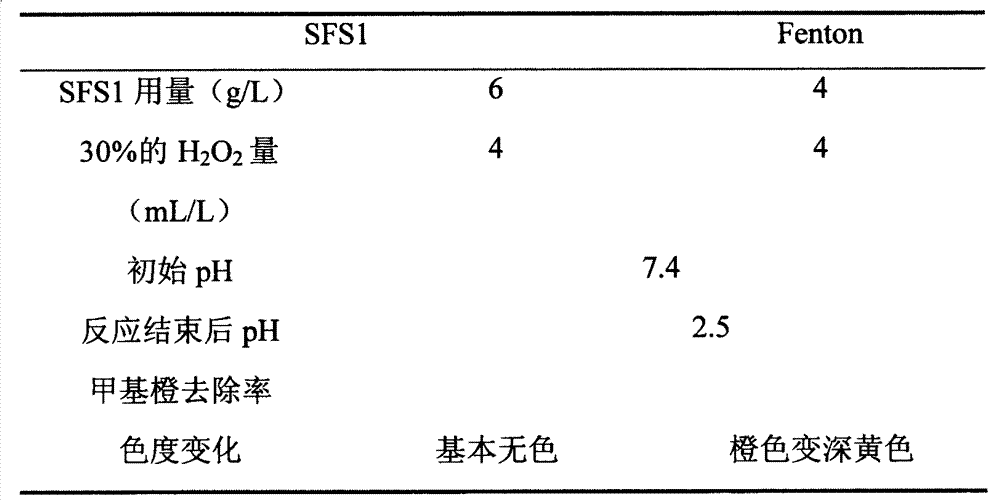Method for preparing binary-oxide composite solid acid catalyst and method for treating degradation-resistant organic pollutants by catalyzing oxidization of H2O2
A H2O2, solid acid technology, applied in oxidation water/sewage treatment, water pollutants, water/sludge/sewage treatment, etc., can solve the problems of easy precipitation of catalysts, limited application scope, high chromaticity of wastewater, and achieve good Catalytic effect, saving acid and base, effect of simplifying process
- Summary
- Abstract
- Description
- Claims
- Application Information
AI Technical Summary
Problems solved by technology
Method used
Image
Examples
Embodiment 1
[0023] According to the mass ratio m(SnCl 4 .5H 2 O): m (diatomaceous earth) = 1: 3, weigh a certain amount of SnCl 4 .5H 2 O and diatomaceous earth, stir vigorously to mix, then add a certain amount of Fe 2 (SO 4 ) 3 , adjust pH=6 with concentrated ammonia water to form Sn(OH) 4 and Fe(OH) 3 Sol. The product was aged in a water bath at 70°C for 12 hours, and then added with 0.1-0.75mol / L (NH 4 ) 2 CO 3 Washing with aqueous solution, centrifuging and settling, drying at 90°C, grinding and sieving with 80 meshes to obtain the precursor of tin-iron-silicon mixed oxide. The precursor is impregnated with 0.25-3mol / L sulfuric acid, filtered, dried at 60-120°C, and roasted at 200-500°C for 3 hours to obtain a tin-iron-silicon solid acid with sulfate as a promoter (hereinafter referred to as SFS1) . The particle size of the catalyst prepared by this method is about 100nm. The structure of the above samples was characterized by nitrogen adsorption, and the acid content wa...
Embodiment 2
[0025] Take 50mL of Cuilan dye wastewater and put them in 100mL beakers respectively, the initial COD concentration is 500mg / L, adjust the pH value to 3, 5, 7, 8.5 with hydrochloric acid and sodium hydroxide in turn, add 30% H 2 o 2 1mL / L and catalyst SFS13g / L, turn on the magnetic stirrer, take samples within the set time, and detect the COD, pH and chromaticity of the treated wastewater. The results are shown in Table 1. The results show that the method can be used in a wide range of pH, and the treatment effect is not affected when the pH value is between 3 and 8.5. And within a short period of time, the color removal rate can reach 100%, and the decolorization effect is very good. After the reaction, the pH value of the wastewater was around 3.
[0026] The influence of table 1 different initial pH on reaction effect
[0027]
[0028] Example 2
[0029] Take 50mL of methylene blue cationic dye simulated wastewater into 200mL beakers, the initial concentration is 10...
Embodiment 3
[0033]Take 50mL of simulated methyl orange anionic dye wastewater into 200mL beakers, the initial concentration is 200mg / L, do not adjust the initial pH value, turn on the magnetic stirrer, take samples at the set time of 15 minutes, and measure the methyl orange in the wastewater. Orange content and calculate the removal rate. The experimental results are shown in Table 3
[0034] Table 3 Catalyst treatment example of methyl orange wastewater
[0035]
PUM
| Property | Measurement | Unit |
|---|---|---|
| particle diameter | aaaaa | aaaaa |
Abstract
Description
Claims
Application Information
 Login to View More
Login to View More - R&D
- Intellectual Property
- Life Sciences
- Materials
- Tech Scout
- Unparalleled Data Quality
- Higher Quality Content
- 60% Fewer Hallucinations
Browse by: Latest US Patents, China's latest patents, Technical Efficacy Thesaurus, Application Domain, Technology Topic, Popular Technical Reports.
© 2025 PatSnap. All rights reserved.Legal|Privacy policy|Modern Slavery Act Transparency Statement|Sitemap|About US| Contact US: help@patsnap.com



